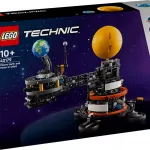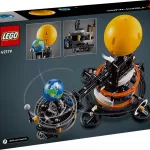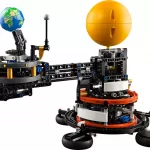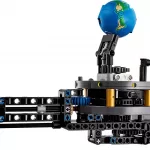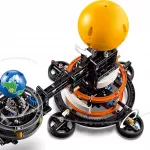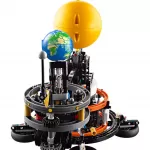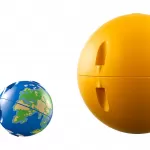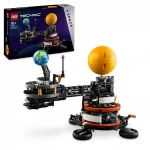Review by Ben Groot (SAFOLs Member, CapeLUG EXCO)
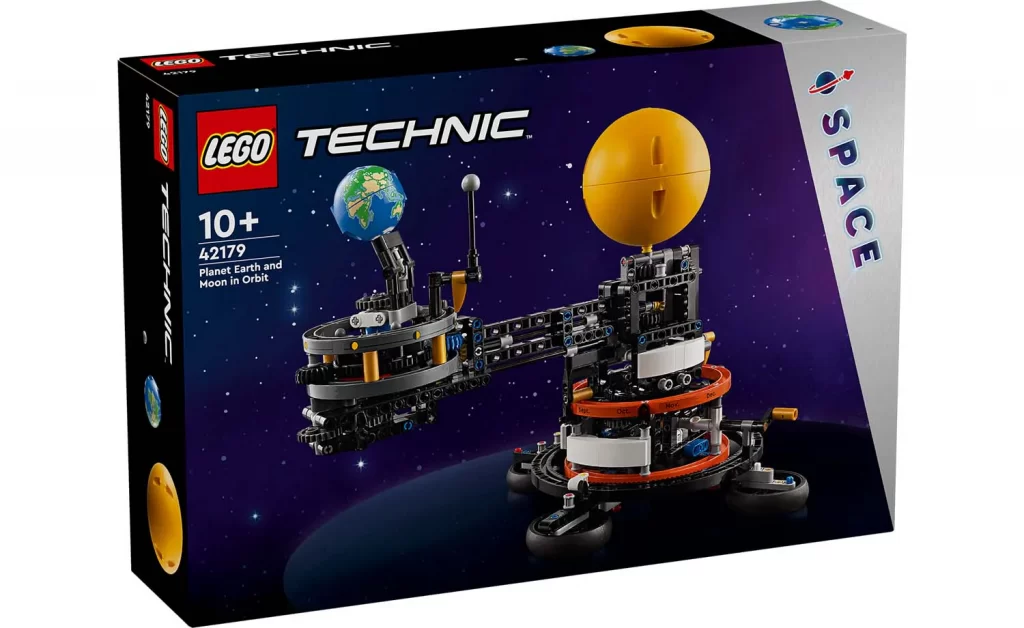

Having been interested in astronomy for most of my life, when I saw that the LEGO® Group was launching an orrery, albeit in smaller scale, I just had to get my hands on the set. The question is, does this set do justice to its name and the excitement of seeing the earth and moon in orbit around the sun?
Firstly, it must be kept in mind that this set is aimed at ages 10+, and one therefore should not expect the sophistication that goes along with an 18+ set. Having said that, the build requires one to focus on getting the gears right, but it was easy enough for my 9-year-old daughter to enjoy lending a hand with some parts. Secondly, with this being LEGO® parts and gears, one would expect that the orbits would not be very accurate. It seems as if different reviewers obtained different results, but, on my build, it takes about 10 rotations of the handle for the moon to complete one full orbit of the earth, but it did rotate approximately 13 times around the earth (months) during one full rotation of the earth around the sun (a year). Not terribly accurate, but still reasonable, and the proportions are correct, nonetheless.
Turning to the build itself, the box comes with four of the new paper bags. Most of the bags, as usual, contained smaller bags inside, although, curiously, bag 3 contained a plastic bag. The box also contains a plastic bag containing the earth parts, the four wheels used as a base, and the two dark grey rings. The two halves of the sun globe, the two large orange rings and a small sticker sheet are all loose in the box.

Bag 1, naturally, starts out with the base of the set. It is a fairly quick and easy build and took no longer than 20 minutes to complete. Interestingly, though, not all the components on the four feet are symmetrical once completed, as I have come to expect from LEGO®. More about this later.

Bag 2 completes the base and ends off with the stickers for the months of the year being applied. In all, there are only 10 stickers to be applied, six of which contain the months of the year, and the remaining four showing the moon phases. This is sure to please many builders. The stickers were not too difficult to align properly.

When building bag 3, the rest of the gear mechanism driving the arm on which the earth and moon are situated, are completed. Whilst building this part, I thought that I had an error, as the arm was moving freely, so I rebuilt it three times! Turns out I just had to be patient, the mechanism is soon connected and properly fixed.
Finally, getting to bag 4, the mechanism on which the earth and moon rotates, is built. Once this is done, the entire set is put together. In all, total building time is approximately 90 minutes, but this would of course depend on your individual build speed.
With a set like this, there are very few repetitive builds, which is quite nice. The four wheels, two orange circle beams, and the earth and sun globes are unique to this set. The set also contains quite a few of the newer beams with holes, which are welcome in any Technics collection. In all, with a part count of 526, the set has a very useful number of parts that can be used elsewhere. The printed earth globe attracted some criticism, but I was quite satisfied with it, especially considering the relatively small scale. I particularly liked the fact that quite a bit of the mechanism as well as many gears are exposed – it gives one a sense of movement, and shows the workings of the model, something I always enjoyed. Contrary to what I expected, the movement is very smooth. The roller and indicator for the months roll smoothly on the orange rings. The model is also very stable and does not seem to want to tilt.

Coming to my dislikes about the set, unfortunately there are quite a few. Firstly, there is no provision for a motor to be added to the hand-operated lever. I added a motor to the set, but it is quite clear that it will have to be geared down quite a bit, as the earth is spinning very fast, and the entire effect of the model is then lost. Although adding a few gears and a motor is not undoable, it will require a fairly big change to this part of the model.
Secondly, the model does not seem to have been finished properly: on at least two places a part of an axle sticks out, and on one of the “feet” parts of two pins are sticking out. If one looks at the box, these issues are shown on the photos, so it is not simply poor building on my part. This is unfortunate, as I believe that these issues could fairly easily have been resolved.
Lastly, curiously, there is a mistake apparent only when considering the set from a southern hemisphere perspective: the pointer showing the month corresponds to the northern hemisphere seasons, but not to the seasons in the southern hemisphere. I therefore moved the pointer on my build to be adjacent to the roller, and then the seasons for the southern hemisphere correspond with the month indicated.
In all, this is still a very enjoyable build, and a great educational tool. My daughter was able to see day and night, phases of the moon, as well as the seasons.
The set currently retails just under R1 500. In my view, this is good value for a highly enjoyable build with great display potential. It is sure to attract attention in any display, living room or LEGO® room. So, if you are into a bit of astronomy, or you have children in primary school, this set will, in my view, be an excellent addition to your collection.


